On August 23, 2023, India’s space agency Indian Space Research Organization (ISRO) successfully soft-landed its moon mission Chandrayaan-3 on the south pole of the moon. This makes India the first nation to land a spacecraft on rough terrains near the lunar south pole in human history and the fourth to successfully land a spacecraft on the moon. Till then, only three nations had been able to achieve un-crewed landings on the moon — the Soviet Union, the United States, and China. The United States is the only nation that has successfully achieved crewed landings on the moon.
What is chandrayaan-3?
Chandrayaan-3 is the third moon mission of the Indian space agency ISRO launched under its Chandrayaan program or Indian Lunar Exploration Program. India’s Chandrayaan program is aimed at sending crewed missions to the moon and finding ways to sustain presence on it for future and farther missions in space. The success of Chandrayaan-3 is a feat not just for India but for entire humanity.
‘Chandrayaan’ is a Sanskrit language word meaning moon vehicle; ‘Chandra’ means moon and ‘Yaan’ means vehicle. In Sanskrit, the moon is also referred to by the names ‘Tusharanshu’ and ‘Himanshu.’ Both of which mean ‘one which is partly covered in snow or ice.’ One of the main objectives of Chandrayaan-3 is to find ice on the lunar surface that could supply fuel, oxygen, and drinking water for far space exploration missions.
The mission
The ISRO launched its first moon mission Chandrayaan-1 in 2008. The spacecraft carried a moon impact probe which was successful in detecting water on the lunar surface. Chandrayaan-1 also performed mapping and atmosphere profiling of the moon.
The second moon mission ‘Chandrayaan-2’ was scheduled in 2013 but was postponed to 2016 when Russia was unable to develop the lander for the space agency. As a result, India decided to develop its lunar mission independently and launched ‘Chandrayaan-2’ in 2019. Chandrayaan-2 was supposed to touch down a lander and a rover on the lunar surface. Though it successfully put an orbiter in a lunar orbit, the mission failed to safely land on the moon. The orbiter continued operation collecting scientific data on the moon and is expected to remain operational for seven and half years.
In the same year, ISRO approved a third mission to the moon ‘Chandrayaan-3’ to achieve the incomplete objective of ‘Chandrayaan-2,’ i.e., safely landing a spacecraft on the moon. The new spacecraft aimed to land on the same spot where ‘Chandrayaan-2’ was supposed to. India launched ‘Chandrayaan-3’ on July 14, 2023, at 2:35 PM IST from Satish Dhawan Space Centre in Sriharikota, Andhra Pradesh, India. The mission took 40 days to reach the moon and safely touched down on the lunar surface on August 23.
India’s Chandrayaan-3 and Russia’s Luna-25 both were in a race to land on the lunar south pole for the first time in human history. The Luna-25 mission which was launched on August 10 entered lunar orbit on August 16, but its lander crashed on the moon on August 19 after a failed orbital maneuver. After launch, Chandrayaan-3 entered lunar orbit on August 5 and its lander ‘Vikram’ successfully touched down the lunar south pole on August 23 making India the first country to land a spacecraft on the south pole of the moon.
Chandrayaan-3 has successfully demonstrated India’s indigenous technology to land a spacecraft safely and successfully on the challenging terrains of the moon’s far side. The mission now aims to successfully demonstrate the movement of its rover ‘Pragyan’ on the difficult terrains of the South Pole. The rover will perform several scientific experiments on the lunar surface.
The ISRO’s next moon mission, ‘Chandrayaan-4,’ is expected to launch in 2026~28. It will be a collaborative mission with Japan’s space agency JAXA and will be aimed at on-site sampling on the lunar surface.
The launch vehicle
LVM3 is the launch vehicle used for both Chandrayaan-2 and Chandrayaan-3. LVM-3 is the operational heavy-lift launch vehicle of ISRO. This is the fourth operational flight of LVM3 that launched Chandrayaan-3 to Geo-Transfer Orbit (GTO). LVM3 is India’s largest and heaviest launch vehicle used to ferry Indian and international customer satellites. It is used by India to launch multi-satellites, multi-orbit (LEO, MEO, GEO) satellites, and interplanetary missions.
The spacecraft
The Chandrayaan-3 spacecraft consists of three main components — a propulsion module, lander module ‘Vikram,’ and rover ‘Pragyan’, all developed independently and indigenously.
The propulsion module carried the lander module and rover from injection orbit to 100 km lunar orbit. The module also carried a spectropolarimeter of habitable planetary earth (SHAPE) payload, the only payload on the propulsion module, for spectral and polarimetric measurements of Earth from the lunar orbit. It uses a bi-propellant propulsion system (MMH+MON3) and relies on an S-band transponder for communication with the ground control station.
The lander module ‘Vikram’ is named after the father of the Indian space program Vikram Sarabhai. It is about 2 meters tall and has a mass of just 1,700 kg. It is powered by a solar array and a battery. The lander module is equipped with four legs and four landing thrusters for safe landing on the moon. For communication with the Chandrayaan-3 orbiter and ground control station, the module uses ISDN channels. It can communicate data to the ground control station directly or through the orbiter. The lander is responsible for soft landing on the lunar surface. After successfully soft-landing on the lunar south pole, the lander will remain operational for 14 earth days (1 lunar day) on the moon. The lander module has three payloads onboard.
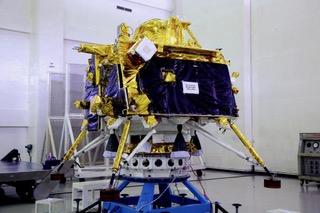 The rover is named ‘Pragyan,’ which means ‘wisdom’ in Sanskrit. It is about 1 meter long and has a mass of about 27 kg. It is equipped with six wheels that will help it to move around the lunar surface. The rover is equipped with two payloads, a terrain camera, and a panoramic camera.
The rover is named ‘Pragyan,’ which means ‘wisdom’ in Sanskrit. It is about 1 meter long and has a mass of about 27 kg. It is equipped with six wheels that will help it to move around the lunar surface. The rover is equipped with two payloads, a terrain camera, and a panoramic camera.
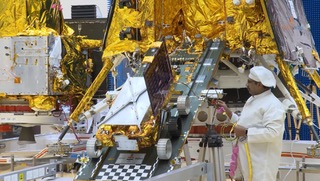 4 hours after successfully landing on the moon, rover Pragyan ramped down from the lander to the lunar surface. It will explore the surrounding area for a period of 14 days. The rover will travel at a speed of about 1 cm per second and will be able to cover a distance of about 500 meters. The rear wheels of the rover will leave imprints of India’s national emblem and ISRO logo on the moon’s surface.
4 hours after successfully landing on the moon, rover Pragyan ramped down from the lander to the lunar surface. It will explore the surrounding area for a period of 14 days. The rover will travel at a speed of about 1 cm per second and will be able to cover a distance of about 500 meters. The rear wheels of the rover will leave imprints of India’s national emblem and ISRO logo on the moon’s surface.
Check out the following video of rover ‘Pragyan’ rolling out to lunar surface taken by Chandrayan-3 lander Vikram:
Pragyan aims to study the chemical composition and mineralogy of the lunar surface, map the surrounding area, take panoramic images of the surroundings, and search for water on the moon. By the time of this writing, Pragyan has already a moonwalk of 8 meters. It will have communication through the lander module throughout its 14-day-long moonwalk. The landing site of the Chandrayaan-3 lander and rover is exactly 625.64 km from the lunar south pole.
Payloads and equipment
Chandrayaan-3 is carrying a total of 6 payloads. The propulsion module is to stay as an orbiter currently in an orbit of 153 x 163 km inserted before separation of the lander module. It is carrying a spectropolarimeter of the habitable planet Earth (SHAPE). This is the only payload on the propulsion module of Chandrayaan-3. It is an experimental payload to study the spectro-polarimetric signatures of the habitable planet Earth in the near-infrared (NIR) wavelength range (1~1.7um).
The lander module is carrying three payloads:
RAMBHA-LP Langmuir probe: It will measure near-surface plasma density (ions and electrons) and its variation with time.
ChaSTE: Chandra’s surface thermo-physical experiment (ChaSTE) will carry out measurements of the thermal properties of the lunar surface near the polar region.
ILSA: Instrument of lunar seismic activity (ILSA) will measure seismicity around the landing site and delineate the structure of the lunar crust and mantle.
The lander is also equipped with two cameras:
Vikram Lander Imager (LI) Camera-1: This camera is located on the top of the lander and is used to take images of the lunar surface during the descent and landing. It has a resolution of 1024×1024 pixels.
Lander Position Detection Cameras (LPDF): These cameras are located on the sides of the lander and are used to track the lander’s position during the descent and landing. They have a resolution of 256×256 pixels.
There are several sensors on the lander module including an Altimeter (to measure the height of the lander from the lunar surface), an IMU (to measure the lander’s orientation and angular velocity), and a positioning sensor (to determine its position on the lunar surface). Apart from all these payloads and sensors, the lander module is equipped with a navigation system, communication system, power system, and thermal control system.
The rover ‘Pragyan’ is carrying two payloads:
APXS: Alpha Particle X-Ray Spectrometer (APXS) will measure the chemical composition and infer mineralogical composition for understanding the lunar surface.
LIBS: Laser Induced Breakdown Spectroscope (LIBS) will determine the elemental composition of lunar soil and rocks around the lunar landing site.
Apart from these payloads, Pragyan is equipped with a terrain camera (to map the surrounding area), a panoramic camera (to capture panoramic images of the moon), a magnetometer (to measure magnetic field of the moon), dust detector (to measure amount of dust in lunar atmosphere), temperature sensor (to record ambient temperature on moon), communication system with lander ‘Vikram’ and Chandrayaan-3 orbiter, navigation system and power system.
The journey
Following is a brief timeline of the Chandrayaan-3 mission:
July 14, 2023: Chandrayaan-3 is launched from the Satish Dhawan Space Centre.
July 15, 2023: Chandrayaan-3 enters Earth orbit.
July 17, 2023: Chandrayaan-3 enters a translunar trajectory.
August 5, 2023: Chandrayaan-3 enters lunar orbit.
August 17, 2023: The lander module separates from the orbiter module.
August 18, 2023: The lander module begins its descent to the lunar surface.
August 23, 2023: The lander module lands on the lunar surface.
August 23, 2023: The rover is deployed from the lander module.
Will Chandrayaan-3 return to Earth?
No, Chandrayaan-3 is not designed for a return journey to Earth. The lander Vikram’ and rover ‘Pragyan’ will explore the moon for 14 earth days and will be left on the moon after concluding the exploration. Chandrayaan-3 orbiter will remain operational for 7.5 years and continue collecting scientific data from the moon.
Why Chandrayaan-3 matters?
Chandrayaan-3 has landed near the south pole of the moon. This particular region of the moon is of great scientific interest due to some unique features. The lunar south pole is characterized by the presence of permanently shadowed craters where it is possible to find depositions of volatile substances like water ice. These craters never receive direct sunlight and have extremely cold temperatures. Before Chandrayaan-3, no other nation landed a spacecraft on the south pole of the moon due to its extremely challenging terrain. If the presence of water ice is confirmed by Chandrayaan-3, it will be a valuable resource for further lunar exploration, using the moon as a base for crewed missions to deep space or even exploring possibilities of human settlement on the moon. Chandrayaan-3 will also be useful in understanding the geological history of the moon and the processes that shaped its surface.
Unlike China and Russia, India is a signatory of the Artemis Accord along with the United States and nearly 30 other countries. The United States is planning to resend astronauts to the moon by 2030 with the first human landing to be known as the Artemis III mission scheduled for 2025~26. The Artemis mission aims to send the first woman and first person of color to the moon. The international space mission aims to establish a long-term presence on the moon and use the moon as a gateway to send the first astronauts to Mars. Chandrayaan-3 will be helpful to the Artemis missions as the lunar south pole is the only region where enduring presence on and around the moon is possible.
Chandrayaan-3 has also demonstrated India’s capability of cost-effective space engineering and exploration. Chandrayaan-3 was launched with a budget of only $74 million, half of the budget of the Hollywood movie Interstellar. The mission has bolstered India’s position for future space tourism.
You may also like:
Filed Under: Aerospace, Defense/Aviation, Featured, Tech Articles



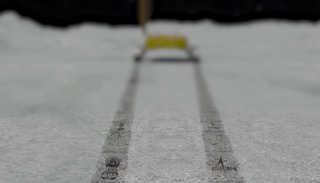


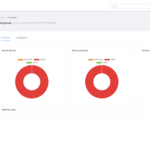

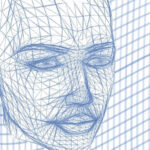

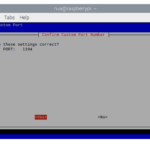

Questions related to this article?
👉Ask and discuss on EDAboard.com and Electro-Tech-Online.com forums.
Tell Us What You Think!!
You must be logged in to post a comment.